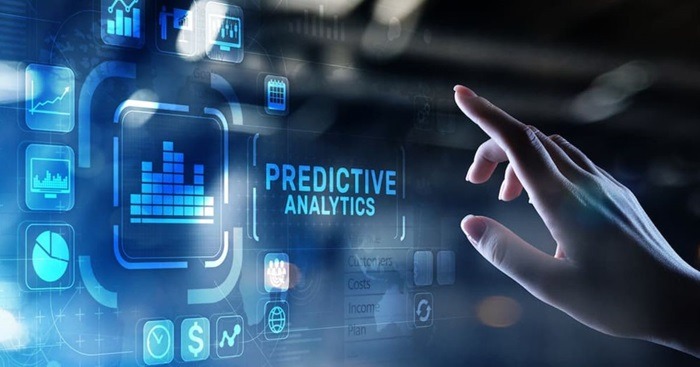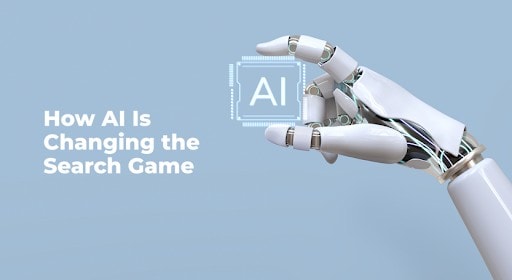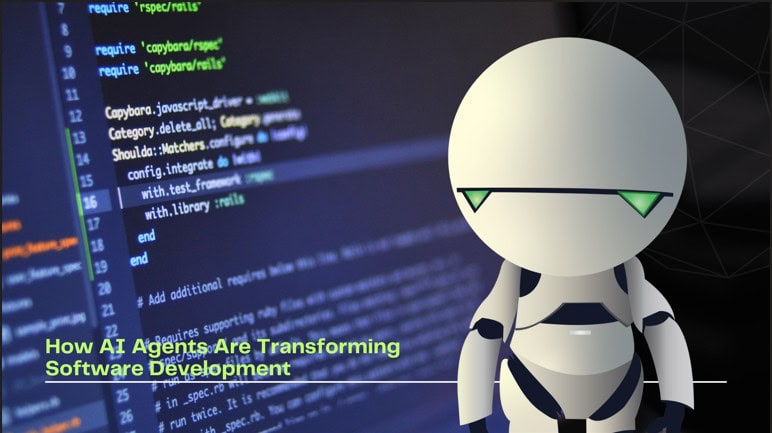Business success hinges on proactivity—being capable of foreseeing future events and leveraging that information to one’s advantage. The linchpin for achieving this? Predictive AI.
While it may sound futuristic, using predictive analytics in business is far from novel. Just ask Henry Ford, who integrated data science analysis into his business practices in the late 19th century. This practice further evolved in the 1960s, propelled by the increasing prevalence of computers.
Fast forward to 2022, and the market size for predictive AI reached a substantial $12.49 billion, highlighting its status as a global phenomenon. Moreover, there’s no indication of a slowdown. Projections indicate that by 2028, it is poised to soar to $38 billion. For businesses yet to embrace predictive analytics, this trend signals a potential risk of falling behind.

What Is Predictive AI?
Before digging into the marketing potential of AI-driven predictive analytics, it’s beneficial to grasp its underlying concept.
Predictive AI, short for Predictive Artificial Intelligence is a subset of artificial intelligence that uses algorithms and machine learning techniques to analyze data and make predictions about future events or outcomes. The primary objective of predictive AI is to forecast and anticipate specific trends, behaviors, or occurrences based on patterns identified in historical data.
This technology involves training models on large datasets to recognize patterns and relationships. Once the model is trained, it can then analyze new data and make predictions or recommendations without being explicitly programmed for the task. Predictive AI is commonly applied in various fields, including finance, healthcare, marketing, and manufacturing, among others.
Furthermore, it aids in recognizing trends, anticipating behavior, foreseeing potential challenges, and formulating proactive solutions. This is where AI systems and AI research emerge as valuable tools for your business, swiftly analyzing complex data to enhance effectiveness and increase return on investment (ROI).
In essence, predictive AI aims to enhance decision-making by providing insights into future possibilities, enabling organizations and systems to make informed choices, optimize processes, and improve overall efficiency.
The Revolutionary Impact of Generative AI on the Future of Marketing
Predictive AI Vs. Generative AI
Everything is going smoothly, but where do AI models such as Midjourney and ChatGPT fit into the picture? Now, we are changing the focus to generative AI—artificial intelligence platforms that specialize in content creation rather than data prediction.
While predictive AI centers around using historical data to anticipate patterns, trends, and behavior, generative AI is all about creative output. This entails producing realistic images, content, music, and more, all with the aid of machine learning.
Both operate on the foundation of artificial intelligence, but one emphasizes prediction while the other emphasizes creation, aligning with the names of these AI models. Their applications also differ. Generative AI models find their forte in creative industries like film, writing, fashion, and art, whereas predictive AI models excel in sectors relying on data analysis, such as marketing, healthcare, and finance.
Both have their respective niches, experiencing a surge in usage across diverse fields, with an anticipated annual growth rate of 37.3% projected between 2023 and 2030. It’s this escalating popularity that underscores the significance of understanding predictive AI. If you’re not already tapping into its potential, rest assured that your competitors likely are.
Predictive AI and Generative AI represent two distinct branches within the broader field of artificial intelligence, each with its unique focus and applications.
Predictive AI
- Purpose: Primarily centered on predicting outcomes based on historical data and patterns.
- Functionality: Analyzes and interprets past data to forecast future trends, behaviors, or outcomes.
- Applications: Well-suited for industries that heavily rely on data analysis, such as finance, healthcare, and marketing.
- Key Characteristics: Emphasizes making informed decisions and identifying patterns in existing data.
Generative AI
- Purpose: Focuses on content creation rather than prediction.
- Functionality: Creates new, realistic content such as images, text, music, or even entire pieces of art using machine learning algorithms.
- Applications: Particularly beneficial in creative fields like film, writing, fashion, and art where the emphasis is on generating new and imaginative content.
- Key Characteristics: Stresses the ability to generate novel and creative outputs based on learned patterns.
Comparison Between Predictive AI and Generative AI
- Nature of Output: Predictive AI anticipates future events based on historical data, while Generative AI produces new and original content.
- Industries: Predictive AI is well-suited for data-centric industries, whereas Generative AI finds its application in creative and artistic domains.
- Function: Predictive AI focuses on analysis and forecasting, whereas Generative AI emphasizes creative content generation.
- Examples: Predictive AI models may include those used in financial forecasting or healthcare analytics, while Generative AI models encompass platforms like Midjourney and ChatGPT, which create content like text and images.
Both Predictive AI and Generative AI contribute valuable capabilities to the broader landscape of artificial intelligence, catering to different needs and industries based on their distinct functionalities.
A Brief Introduction To Artificial Intelligence In Marketing
The Benefits Of Predictive AI
Before you decide to integrate AI technology into your operations, it’s beneficial to delve deeper into its advantages. While the benefits of generative AI, such as time and cost savings in image generation and content creation, are apparent, the merits of predictive AI are more diverse:
Strategic Future Planning: Staying ahead in the competitive landscape relies on having a distinct advantage, precisely what tools like predictive AI offer. By leveraging historical data to predict trends and outcomes, you gain the ability to plan ahead and adopt a proactive business approach.
Enhanced Efficiency: The quality of your predictive data and the accuracy of your forecasting directly impact your ability to circumvent repetitive tasks and errors, allowing for a more streamlined business process. The more precise the predictions, the greater the potential for improved operational efficiency.
Faster Decision-making: In the realm of marketing, decisions are based on data. The greater the precision of your data, the more judicious your decision-making becomes. Enter predictive AI—an asset that furnishes you with the requisite data precisely when you need it, facilitating quicker and more efficacious decision-making.
Pattern Recognition: Ever contemplated how to leverage your data to uncover patterns, revealing opportunities, challenges, and solutions? That’s precisely the role of predictive analysis. Through the application of machine learning, it identifies patterns in your data, offering guidance for strategic decision-making.
Forecasting Trends: Your data harbors a trove of insights, and predictive AI is adept at extracting this broader knowledge. Using mathematical algorithms, machine learning, and data mining, predictive analytics discern patterns in your data, enabling the anticipation of customer behavior, events, and trends. This ensures you receive invaluable business information well in advance.
The Applications Of Predictive AI
Undoubtedly, one of the most significant advantages of predictive AI lies in its versatility across various applications. With its capacity to enhance efficiency, boost revenue, and streamline processes, it wields the potential to make a substantial impact on diverse industries, including:
-
Healthcare
In the expansive world of healthcare, where patients and medical facilities abound globally, the opportunities for data collection are limitless. Capitalizing on the substantial resources and capabilities of AI models, algorithms can recommend treatments, provide personalized care, and even anticipate the onset of epidemics. This demonstrates how AI not only enhances diagnostic processes but also plays a crucial role in saving lives.
-
Retail Marketing
From tracking market trends to understanding purchasing patterns, predictive AI can trace the entire customer journey comprehensively, analyzing each phase. The dynamic and fast-paced nature of the retail sector aligns seamlessly with AI models that can swiftly analyze, adapt, and respond.
Questions about the potential success of specific products in the market or the effectiveness of particular incentives in securing a sale can all be addressed by predictive AI, offering insights and solutions in real-time.
-
Financial Services
In the financial services sector, predictive AI’s ability to forecast trends and apply machine learning models across a spectrum of transactions and customer interactions positions it as an ideal fit. Its speed, precision, and efficiency have the potential to revolutionize the functioning of the financial world, offering transformative capabilities for enhancing operational processes and decision-making.
-
Automotive
AI holds the promise of rendering vehicle failures and recalls obsolete in the automotive sector. Through the application of machine learning, predictive analytics can identify potential manufacturing failures before they manifest, preventing issues in advance. Looking ahead, predictive AI has the potential to further contribute by aiding in the development of automotive technology and driverless vehicles through insights derived from the study of driver behavior.
Predictive AI Tools
Let’s explore the types of predictive AI tools available and their functionalities:
Neurons
First in line is Predict AI from Neurons. What sets it apart is its foundation on a database of eye-tracking data amassed from over 120,000 individuals globally, consisting of more than 100 billion data points of brain responses.
Using these neuroscience studies as the basis for its models, Predict AI can swiftly generate creative insights data, enhancing conversion rates and accurately predicting human behavior. Thanks to its innovative AI technology, you gain insights into how and why customers respond to your brand and advertisements. This, in turn, facilitates heightened brand awareness and increased sales. Anticipate improved engagement and optimized creativity, all powered by Predict.
Vizit
What sets your marketing campaigns apart in enticing customers to view and purchase your products? This is precisely the question that Vizit aims to address. Fueled by award-winning AI, Vizit uses patented technology to replicate the visual and sensory experiences of your customers when they engage with your products.
Given that an estimated 93% of customers rely on visuals to make their purchasing decisions, understanding how to capture their attention is paramount for success. With predictive AI based on millions of behavioral interactions, Vizit assesses your visual content and provides insights to enhance your performance.
Helping you to test, learn, and expand, Vizit offers a perspective aligned with your customers’ viewpoints. With Vizit’s track record of ensuring increased conversions by up to 45% and fostering sales growth of 30%, adopting this tool could offer you a truly rewarding perspective.
Dragonfly AI
Although it originated as an app, the Dragonfly AI platform has evolved into a powerhouse, particularly renowned for its emphasis on content performance.
Offering a comprehensive suite of AI tools, Dragonfly’s Studio desktop solution, geared towards visual predictive analytics, enables you to improve ROI, assess performance, conduct A/B testing on creatives, and streamline the design process—all within a single platform. With versatility across iOS through a mobile app and browser accessibility via an extension, Dragonfly AI harnesses AI technology seamlessly. The ultimate goal? Ensuring that your targeted messages reach the right customers at precisely the right time, and provide a substantial boost to your bottom line.
How To Use Predictive AI to Scale Up Your Marketing Objectives
While there’s an ongoing discussion about the potential decline in the quality of generative AI, such as OpenAI’s ChatGPT, the advantages and applications of predictive AI remain evident. Machine learning and artificial intelligence are not merely futuristic concepts—they are integral aspects of our present reality, continually advancing in sophistication.
Would you like to read more about “How to Use Predictive AI to Amplify Your Marketing Objectives” related articles? If so, we invite you to take a look at our other tech topics before you leave!
Use our Internet marketing service to help you rank on the first page of SERP.
![]()











